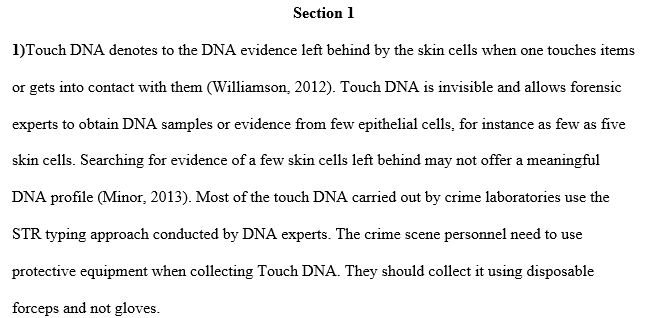Possible evidentiary value of Junk DNA
Question description: Section 1
1) What is Touch DNA? How is Touch DNA detected, preserved, and collected?
2) Describe the collection of biological stains including variances between dry, wet, and liquid stains. What are the four
primary conditions in which a stain may be encountered?
3) What is PCR analysis? When was this method first described? Why is this application important particularly for cold
cases or cases in which only a small amount of DNA is discovered?
4) What is STR analysis? Why is this an effective method for DNA typing?
5) What is AFLP analysis? What is RFLP analysis? Why are these effective methods for DNA typing?
Section 2
1) Evaluate Fourth Amendment issues as they relate to the collection of DNA evidence, specifically in reference to
search and seizure issues.
2) Select one of the following DNA-related criminal cases listed below. Briefly summarize the case and critique its
relevance to the Fourth amendment reasonableness test, particularly as it relates to post-conviction DNA collection.
Wilson v. Collins
United States v. Weikert
United States v. Amerson
United States v. Pool
United States v. Mitchell
3) What is Junk DNA? Analyze the possible evidentiary value of Junk DNA.
4) Utilizing the State Law research tool on the Innocence Project Website, select a current State and review the current status of the State’s compensation laws, DNA access laws, and State laws requiring a recorded interrogation. Provide a brief analysis of your research from the State of your choosing.
Section 3
1) Describe the current status of international wildlife crime including the illegality of the underground wildlife trade.
How might forensic DNA applications be used to detect these crimes and to ideally deter future occurrences of
illegal poaching and smuggling operations? The research on this crime is extensive, you are encouraged to
perform external research exclusive of this week’s class reading assignments.
2) Evaluate contemporary operational considerations in reference to DNA typing in wildlife investigations.
3) Locate a contemporary legal case involving the use of DNA applications and their significance in the detection or
apprehension of criminals involved in the illegal wildlife trade. Briefly discuss the case, evaluate the specific DNA
application(s) used in the case, and discuss how the case was ultimately solved. Critique the law enforcement and
forensic response in reference to case solvability.
Solution preview for the order on possible evidentiary value of Junk DNA
APA
1435 words
